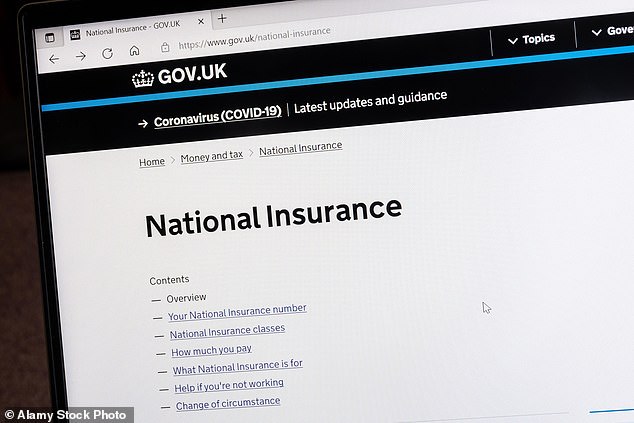Table of Contents
More than 10,000 smart savers have boosted the value of their state pension – one of them up to £148,922 – since April using a rare government offer.
A special window is open allowing you to buy up to 11 additional qualifying years for your state pension, if you have gaps in your National Insurance (NI) record.
But hundreds of thousands of people who have not yet increased their retirement income have just three months left to do so.
Experts have called this generous one-time offer “one of the best investments you can make.”
Chancellor Rachel Reeves. The state pension is paid from the age of 66 and the amount received will depend on several factors
The scheme means you could spend up to £8,240 and see a net increase of £88,306 in your income over a 20-year retirement, assuming the state pension rises each year under the triple lock, calculations from wealth manager Quilter show .
Savers made more than 10,000 payments worth £12.5 million between April and October alone to boost their state pensions through the Government’s new dedicated online service.
In the most extreme example, a saver managed to increase his state pension income by almost £149,000. This would cost around £15,500 today.
The deadline to take up the offer was due to be April 2023, but it was extended twice after Money Mail and This is Money warned that many anxious savers were unable to top up their pensions due to administrative chaos at the Department for Work and Pensions.
The deadline has been pushed back to April 5 this year, meaning savers now have less than three months left to make use of the generous offer.
So how do you know if you’re one of the hundreds of thousands who stand to win? Here we explain everything you need to know to take advantage of it and how much it will cost to increase your state pension in the future.
How much state pension should I receive?
Currently, the state pension is paid from the age of 66 and the amount received will depend on several factors. This includes when you reached retirement age, how many years you worked, your type of employment (self-employed or employed), and how much you earned.
There are two types of state pension. The “basic” state pension is paid to those who reached retirement age before April 6, 2016. The new “flat” state pension is paid to those who reach retirement age after that date.
Anyone receiving the “basic” state pension needed 30 years of NI contributions to qualify for £169.50 a week, or £8,814 a year. It came with several supplements, including the second state pension, but this was affected by the so-called “contracted” pensions.
Those receiving the ‘new’ state pension need a further 35 years of NI contributions to get the full amount: £221.20 a week, or £11,502 a year.
Anyone who has not met these NI requirements will receive a smaller pension in retirement. Therefore, it is important to identify any deficits if you did not know they had occurred.
How can I increase my state pension?
The main way to increase the amount you receive in your state pension is by filling in any gaps in your NI contribution record, a process known as state pension top-ups.
You can pay to purchase missing NI contributions for specific years during which you did not make them or did not pay enough NI to accrue entitlement.
This is different to the NI contributions that employed workers make each month, which are paid as a percentage of their income.
Each week you want to make voluntary contributions to NI to cover costs of £17.45 this tax year. So if you wanted to complete a full year, it would cost you £909.95.
At the current exchange rate, this increases your pension by £329 a year. This equates to £6,573 over a 20-year retirement, without taking into account any increase in the state pension under the triple lock. This is the Class 3 contribution rate, the most common rate workers pay.
Those who are self-employed usually pay the Class 2 rate, which is much lower than that of employees: currently £3.45 a week, or £179.90 a year. This means it costs much less to fill gaps in a record but creates the same boost in the state pension.
If you have a partial year, for example where you worked for part of the year but didn’t pay enough NI to make it a qualifying year, then the price of filling that year will often be much cheaper than a year you missed. entirely.
Most savers who increased their state pension this year paid to top up a year’s NI contributions and paid an average of £1,193, according to official figures.
The biggest increase anyone made to their state pension was £107.44 a week. Money Mail analysis finds this could add up to almost £149,000 for someone who lives to be 90, with the state pension rising a minimum of 2.5 per cent under the triple lock.
What is the deadline?

To check your NI contribution record, contact the Government Future Pensions Centre.
You can usually only fill gaps in your NI record dating back to the last six years. But a unique window is currently open that allows it to fill any gaps dating back to 2006.
You have until April 5, 2025 to apply and make the corresponding payments. After that, the rules will return to normal and you will only be able to cover the last six years.
But it is important not to leave it to the last minute if you plan to carry out any historical recharge.
The Government has already pushed back the deadline to give those struggling time to contact the Department for Work and Pensions the chance to complete the top-up. This means they are unlikely to do it again.
Jon Greer, head of retirement policy at Quilter, says: “Although April 2025 may seem distant, starting the process early is crucial if you want to avoid missing out on a substantial increase in your state pension.”
‘Previously, there were reports of jammed phone lines and slow processing due to the high volume of last-minute requests.
“To avoid these issues, it is important to consider making a voluntary additional NI top-up as soon as possible and use the Check Your State Pension forecasting tool by logging into your account online or using the free and secure HMRC app.”
How do I know if I can use the offer?
A new online tool to top up state pensions was launched last year.
You can access your state pension provision online and buy top-ups at gov.uk/check-state-pension.
To check your NI contribution record and how much you are on track to receive in the state pension, contact the Future Pensions Center on 0800 731 0175 if you are under 66, or the Pensions Service for those over the age retirement on 0800 731 7898. You will be asked for your name, date of birth and NI number.
They can tell you which years you are eligible to make additional contributions and whether you will benefit.
There are several reasons why you may be missing NI contributions for some years.
For example, you may have been employed part-time, earned less than the threshold for making NI payments, or taken time off work to care for your children or elderly relatives.
Those caring for children or elderly relatives who need care can get free credits, and for other things too. You should first check this, we explain more in our state pension top-up guide.
If you transfer the money without checking it first and it turns out you miscalculated, you risk losing that money forever as HM Revenue and Customs won’t always refund you.
Once you know exactly which years of missing NI contributions you want to make up and how much you need to pay, you need to make the payment to HMRC. First you will need a reference number.
Call the National Insurance Helpline on 0300 200 3500 and an adviser will confirm how much you would have to pay per year and give you an 18-digit payment reference. You can then make the payment through your online banking. through the government website.
Select the ‘pay by bank account’ option. You will then be prompted to log into your mobile or online banking account to approve your payment.
You can also send a check by post to: HM Revenue and Customs, National Insurance Contributions and Employer Office, BX9 1AN.
moneymail@dailymail.co.uk
SAVE MONEY, MAKE MONEY

1% refund

1% refund
About debit card expenses. Maximum £15 per month*

Energy bills

Energy bills
Find out if you could save with a fixed rate

free share offer

free share offer
No account fee and free stock trading

4.5% Isa 1 year

4.5% Isa 1 year
Hampshire confident of Hargreaves Lansdown

Sip Rate Offer

Sip Rate Offer
Get six months free on a Sipp
Affiliate links: If you purchase a This is Money product you may earn a commission. These offers are chosen by our editorial team as we think they are worth highlighting. This does not affect our editorial independence. *Chase: Refund available during the first year. Exceptions apply. Over 18 years of age, resident in the United Kingdom.
Some links in this article may be affiliate links. If you click on them, we may earn a small commission. That helps us fund This Is Money and keep it free to use. We do not write articles to promote products. We do not allow any commercial relationship to affect our editorial independence.


